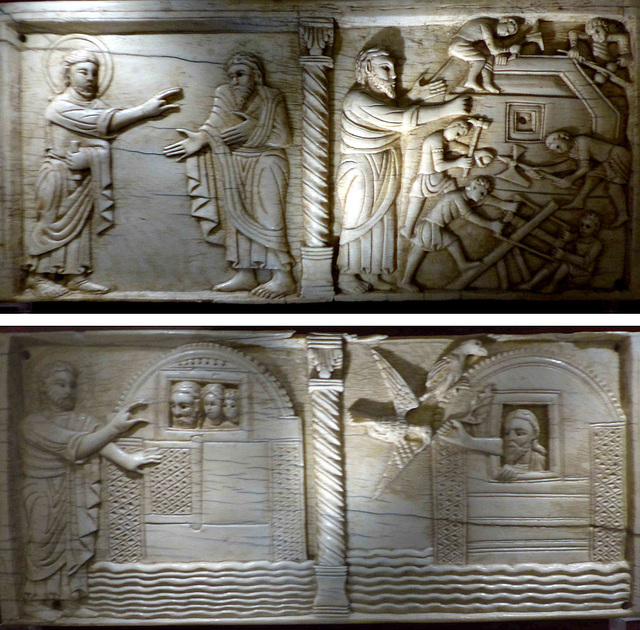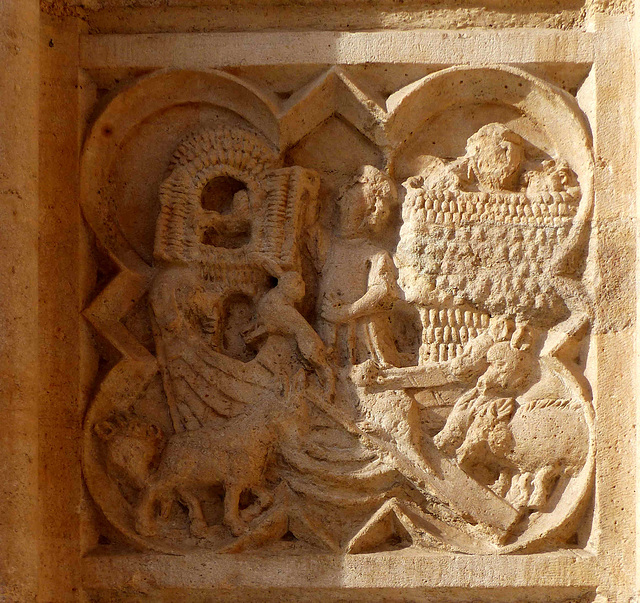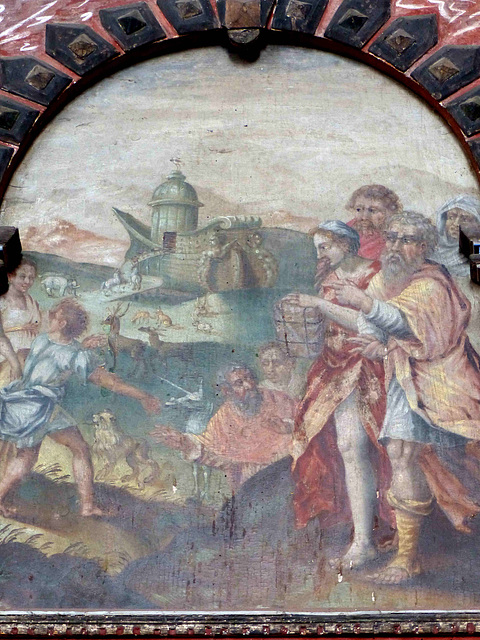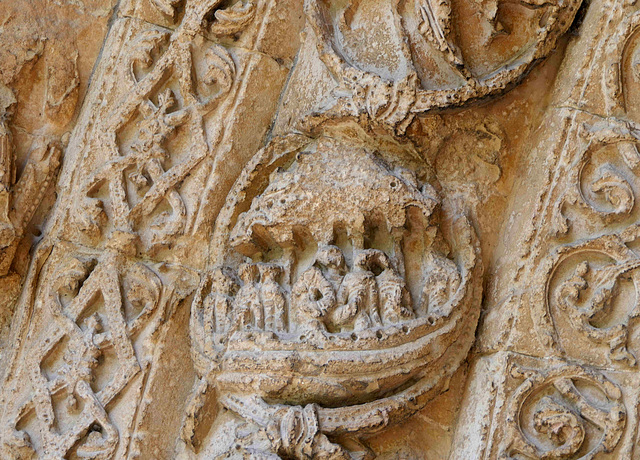
Noah´s many arks
The narrative of a great flood is known since Sumerian time. In the "Epic of Gilgamesh" the ark is a kind of round floating island. Noah`s ark had many forms in the imagination of medieval artists.
01 Feb 2022
Salerno - Museo Diocesano San Matteo
Salerno (pop. ~ 130.000) is located on the Gulf of Salerno on the Tyrrhenian Sea. The site has been one of the most important and strategic ports on the Mediterranean sea, yielding a rich Greco-Roman heritage. It was an independent Lombard principality in the early Middle Ages. The Normans in 1077 made Salerno the capital of their rule in all of southern Italy. In the 16th century, under the Sanseverino family, among the most powerful feudal lords in southern Italy, the city became a center of learning, culture, and the arts.
Salerno has been the seat of an archbishop since 983 and the city's medical school is famous for being the first college or "university" of medieval Europe.
The Diocesan Museum is best known for the "Salerno Ivories". A collection of ivory plaques from around the 11th or 12th century that contain elements of Early Christian, Byzantine, and Islamic art as well as influences from Western Romanesque and Anglo-Saxon art.
It is the largest unified set of ivory carvings preserved from the pre-Gothic Middle Ages and depicts narrative scenes from both the Old and New Testaments. It is supposed the ivories originated in either Salerno or Amalfi, which both contain identified ivory workshops, however, neither has been definitively linked to the plaques so the city of origin remains unknown.
Noah´s ark
Florence - Battistero di San Giovanni
Florentina was established in Roman times as a settlement for veteran soldiers. The name had changed already when young Charlemagne conquered the town in 774. It became part of the Duchy of Tuscany, with Lucca as the capital. Around 1000 Margrave Hugo chose Florence as residency instead of Lucca. After the death of Matilda of Tuscany (1115), the Florentines formed a republic ruled by a council. The town prospered, despite a constant fight between the different factions and noble families.
In the 15th century, Florence was among the largest and wealthiest cities in Europe. This was when the Medici family entered the political scene. As a dynasty of art-loving, power-hungry bankers, they made Florence the birthplace of the Renaissance.
The Baptistery of San Giovanni is the baptistery of Florence Cathedral. The time of origin is disputed, the church was consecrated in the 11th century. The church stands on the foundations of a Roman building. The first reliable source dates from 897, when an ecclesia (church) dedicated to John the Baptist and facing the bishop's palace is mentioned.
Today's building dates from the 11th century at the earliest. The octagon had been a common shape for baptisteries for many centuries since early Christian times. The construction was finished in 1128. An octagonal lantern was added to the roof around 1150. It was enlarged with a rectangular entrance porch in 1202, leading into the original western entrance of the building, that in the 15th century became an apse, after the opening of the eastern door facing the western door of the cathedral by Lorenzo Ghiberti.
The interior is divided into a lower part with columns and an upper part with a corridor. The interior walls are clad in dark green and white marble inlaid with geometric designs. The marble lining of the interior began in the second half of the eleventh century.
From 1225, the dome was decorated with one of the world's largest mosaic cycles, with a diameter of 26 m in eight rings by famous artists such as Giotto or Cimabue; This mosaic, dominated by a mighty figure of Christ, was only completed after 50 years. The cyclorama was created between 1260 and 1275 and has a diameter of eight meters.
Details of the mosaic:
The Story of Noah's Ark
Lyon - Cathédrale Saint-Jean-Baptiste
Colonia Copia Claudia Augusta Lugdunum (now Lyon) was an important Roman city in Gaul. It was the capital of the Roman province of Gallia Lugdunensis. The Christianization took place very early.
In 177, the Christian community sent a letter naming 48 of their number who had been martyred. In 843 it was ceded to Lorraine and then passed to the Kingdom of Burgundy, whose dominion was entrusted to the Archbishop of Lyon by Frederick Barbarossa in 1157. In 1312 Philip the Fair incorporated Lyon into the kingdom of France.
Lyon was the scene of an urban revolt in 1436 when Charles VII increased taxation. The uprising, mainly of small merchants, lasted a total of two months. During the reign of Louis XI. Four fairs were set up, attracting merchants from all over Europe, especially Italy. Lyon became an important center for the spice trade and, more importantly, the silk trade after François I granted the weaving rights, which until then had been an Italian monopoly. Florentine immigrants also made Lyon a financial center for banking and insurance.
-
It is often said that the most beautiful cities are located on rivers. Lyon is situated on two rivers, the Rhone and the Saone, which meet in the south of the city.
-
The Lyon Cathedral was begun in 1180 on the ruins of a 6th-century church and completed in 1476.
In 1245, the church hosted the First Council of Lyon, where the Pope declared Emperor Frederick II deposed. In 1274, the Second Council of Lyon was held in the cathedral, mainly to discuss the union of the Catholic Church with the Greek Orthodox. On August 17, 1316, John XXII was elected pope in the cathedral. He was the second of the Avignon popes.
In 1562 the church was devastated by Calvinist Huguenots. In 1600 the cathedral was the scene of the marriage between King Henry IV and Mary de Medici.
The facade from the 14th and 15th centuries is influenced by the flamboyant Gothic style. Episodes from the Old and New Testaments are told in 300 picture panels.
Noah´s Arc
Genesis 7:8-9
"Pairs of clean and unclean animals, of birds and of all creatures that move along the ground, male and female, came to Noah and entered the ark, as God had commanded Noah."
Tangermünde - St. Stephan
Tangermünde Castle was first mentioned in 1009 as "civitate Tongeremuthi" because this is where the Tanger (Tongera) flows into the Elbe. The city was first mentioned in 1275.
From 1373 to 1378 Tangermünde was the second seat of Emperor Charles IV, who appointed his 12-year-old son Wenzel Elector of Brandenburg in 1373. After the death of Emperor Charles IV, there was a turbulent development in the Mark, until the Hohenzollerns were enfeoffed with the Mark as electors in 1415 and initially resided in Tangermünde.
The heyday of the Hanseatic city was the 15th century, when the city gates and the town hall were built in the North German brick Gothic style. At this time, St. Stephen's Church was expanded into a Gothic hall church. The city lost the Elector's favor after the uprising of 1488, when the citizens rebelled against the beer tax.
In 1617 the city burned down almost completely. After the fire, many magnificent half-timbered houses were built. Due to the Thirty Years' War, however, the city became a rather insignificant country town.
-
The predecessor of St. Stephan was a Romanesque basilica. It was in existence by 1188. Parts of this original building were reused in the construction of the present church. The transept of the former building gave the width of the new nave. Emperor Charles IV, who lived in Tangermünde between 1373 and 1378, founded a house of Augustinian Canons, to which he gave the church as a source of income. The canons conducted the services.
During the late Middle Ages the construction took place in several phases of today's triple-aisled Gothic hall church. Firstly, after 1350, the northern wall of the nave and the southern wall were built, and in about 1405, the roof and the rib vaults. The prominent octagonal pillars are unusual. The south tower remains uncompleted to this day. In 1450 work began on the construction of the new choir, followed by the outside walls of the new ambulatory and also the arms of the transept. Only then was the old choir removed. The choir was roofed in 1475. The city-wide fire from 1617 damaged the church and the top part of the north tower collapsed. It was not restored until after 1714, when the tower received its present Baroque roof.
A "Biblia Pauperum" (Bible for the poor) was attached to the north gallery of the church in 1620. In this way, the parishioners who could not read were able to experience the stories of the Bible in pictures.
Noah's Ark. In the backdrop the elephants are approaching the ark.
Salisbury - Cathedral
The Iron Age castle rampart of "Old Sarum" was built in the 4th century BC. This was later used as a fortress by the Romans, the Anglo-Saxons and finally, from the 11th century, by the Normans.
At the time of the Saxon invasions, Old Sarum fell to King Cynric of Wessex. The Saxons favoured settlements in the lowlands and largely ignored Old Sarum until the Viking invasions prompted King Alfred of Wessex to rebuild the fortifications. However Old Sarum was abandoned by its inhabitants and was sacked and burnt down by the Danish-Norwegian king Sweyn Forkbeard in 1003. After the Norman invasion a castle was built by 1070, which was directly under the control of the Norman kings.
In 1075, the Council of London installed the first Bishop of Salisbury, named Herman. He and his successor, Saint Osmund, began the construction of the first Salisbury cathedral, that was completed in 1092.
In 1220, Bishop Richard Poore of Sarum began building a new cathedral about three kilometres away in the valley south of the fortress of Old Sarum. This was the nucleus of today's city of Salisbury, initially under the name New Sarum. Just seven years later, Salisbury was granted city rights. The cathedral was consecrated in 1258 after only 38 years of construction.
Due to the short construction period of the cathedral, its architectural style largely corresponds to the early English Gothic style. The free building site and the generous financial support of Henry III were decisive for the rapid completion. The crossing tower, which was added in the early 14th century, has been the tallest church tower in Great Britain at 123 metres since 1561, after the collapse of the crossing tower of the old St Paul's Cathedral.
The only major sections begun later were the cloisters, added in 1240, the chapter house in 1263, the tower and spire, which at 123 m dominated the skyline from 1330. In total, 70,000 tons of stone, 3,000 tons of timber and 450 tons of lead were used in the construction of the cathedral.
In the 17th century, Christopher Wren designed restoration measures to strengthen the central pillars, which by then had visibly deformed under the weight of the tower and spire. Significant changes to the cathedral were made by the architect James Wyatt in 1790, including the replacement of the original rood screen and demolition of a bell tower which stood northwest of the main building.
The floor plan of Salisbury Cathedral shows a three-aisled basilica with two transepts.
The chapter house is notable for its octagonal shape, slender central pillar.
A frieze, which circles the interior above the stalls, depicts scenes and stories from the books of Genesis and Exodus.
Noah´s Ark
Malmesbury - Abbey
Malmesbury, the oldest borough in England, became the site of Malmesbury Abbey, a monastery famed for its learning. It was later home to one of Alfred the Great's fortified castles (burhs) for defence against the Vikings. As a market town, it became prominent in the Middle Ages as a centre for learning, focused on and around the abbey.
In the later seventh century, the site of the Abbey was chosen by Máel Dub, an Irish monk who established a hermitage. Towards the end of his life Malmesbury Abbey was founded around 676 by Aldhelm, a nephew of King Ine of Wessex. The town of Malmesbury grew up around the expanding Abbey.
In October 939 Æthelstan, king of Wessex and of the English, died in Gloucester, and in the year 941 his remains were buried in the Abbey.
The Abbey developed an illustrious reputation for academic learning under the rule of abbots such as Aldhelm, John Scotus Eriugena, Alfred of Malmesbury and Aelfric of Eynsham.
The current Abbey was substantially completed by 1180. The 131 m tall spire, and the tower it was built upon, collapsed around 1500 destroying much of the church, including two-thirds of the nave and the transept.
The abbey was closed at the Dissolution of the Monasteries in 1539 by Henry VIII and was sold to William Stumpe, a rich merchant. He returned the abbey church to the town for continuing use as a parish church, and filled the abbey buildings with up to 20 looms for his cloth-weaving enterprise.
During the English Civil War, Malmesbury suffered extensive damage evidenced by hundreds of pock-marks left by bullets.
Cluny did strongly influence the artistic style here. The connection to Cluny was close. Abbot Peter Moraunt had been a monk of Cluny and had been for a time Prior of La Charité.
Unfortunately the carvings of the portal are very weathered. Seen here may be Noah's Ark
Jump to top
RSS feed- Latest items - Subscribe to the latest items added to this album
- ipernity © 2007-2024
- Help & Contact
|
Club news
|
About ipernity
|
History |
ipernity Club & Prices |
Guide of good conduct
Donate | Group guidelines | Privacy policy | Terms of use | Statutes | In memoria -
Facebook
Twitter







